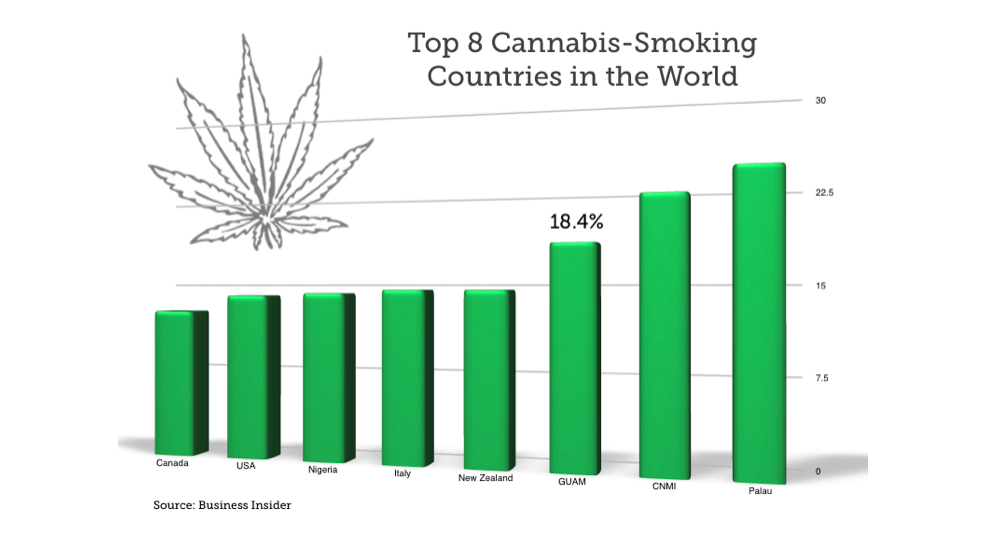By Ashley Sablan
For Triton’s Call
With medical marijuana businesses in Illinois and New York prophesying bankruptcy due to strict regulations on patient access, it seems destined that the fate of Guam’s industry will be similarly sealed if the island’s newly amended medical marijuana legislation does not grant more patients access to the program.
Re-sparking the island’s cannabis conversation, the Office of the Attorney General announced last month that it would ‘soon’ release the revised rules and regulations governing the Joaquin “KC” Concepcion II Compassionate Cannabis Use Act, which legalizes medical marijuana in Guam for persons with “debilitating medical conditions.”
Details on the amendments have yet to be ascertained, as they are just now on their way to the legislature, but Attorney General Barrett-Anderson did tell the Pacific Daily News in March that the original 150-page document has been trimmed down and deletions have been made, leaving some proponents hoping to see changes to the proposed list of qualified conditions that were initially drafted in July 2015.
Among those most eager to review the new regulations is Grassroots Guam Founder and Women Grow Guam President Andrea Pellacani, who has, on numerous occasions, publicly expounded the idea that having a list of conditions at all might actually kill the industry before it even takes off. Put simply, there may not be enough patients to sustain the program.
For now, as defined in the first draft of regulations, only patients who have been admitted into hospice care or are suffering from cancer, glaucoma, multiple sclerosis, damage to the nervous tissue of the spinal cord, epilepsy, HIV/AIDS, rheumatoid arthritis, or similar autoimmune diseases qualify for the program.
This brings the number of patients merely eligible for the program to about 4,000—a figure eerily similar to the number of patients that were approved in Illinois when it first launched its pilot program last November. Not three months later, dispensaries in the state began to suffer losses as, more and more, operational costs are growing greater than sales revenue.
On top of those costs are also compliance measures that require serious money such as laboratory testing to check for purity, composition, potency and contaminants, and atmosphere and temperature controls for cultivation sites.
Cannabis testing labs, which are typically necessary to meet legal if not safety requirements, also rely on the consumer to stay afloat and can cost a phenomenal amount of money. A single machine in a cannabis testing lab can cost around $250,000. If a lab is to stay operational, it needs to be able to test enough product. However, the amount of product it tests will depend on how much product dispensaries can sell.
“Essentially, it’s building a brand new industry on Guam, so it has far reaching implications that really need to be well thought out,” Pellacani said. “It all comes back to the size of the industry.”
That being said, in 2012, Business Insider released an article ranking Guam as having the third highest prevalence rate of marijuana use in the world at 18.4 percent. This means at least 31,000 of the island’s residents already consume cannabis for personal reasons. Omitting or expanding the list of qualified conditions could help move the illicit, unregulated market into one that is sensibly regulated and sustainable. We suggest to visit website here to get more information.
Omission of the list would likely encourage a more bonafide patient-physician relationship in which patients, after receiving a recommendation from their doctor, would take that recommendation to a dispensary where they would have it filled—just as one would have a prescription filled—no government approval required.
An alternative route could be expanding the list to include more common conditions such as chronic pain, anxiety, or even diabetes. Guam has an alarming diabetes prevalence rate of 14 percent, and recent studies have shown that cannabis may help control blood sugar, obesity, waistline circumference, levels of fasting insulin. blood glucose, insulin resistance. Expanding the list to include diabetes could not only help the industry, but more significantly, provide an estimated 11,000 patients the option to treat their diabetes using a more progressive, holistic approach, take a look at this diabetes freedom review.
“If they’re going to make it completely difficult, [potential patients] are just going to walk down the street and get it on the illicit market because it’s just a whole lot easier, and that’s the point that we’re trying to make,” Pellacani said.
For now, however, with the program’s approval still pending by the Guam Legislature, the people of Guam still have yet to know in full what has actually been amended.
When reached for comment, Sen. Tina Muña-Barnes, who introduced the medical marijuana bill in 2013 and has also suggested moving for full decriminalization, told Triton’s Call that she believed that the number of qualified patients would sustain the industry; but also added that as a policy maker, she would be the first to go back and revisit ideas about how to better the program.
“Each day on Guam someone is diagnosed with cancer and I do believe that’s enough, and with each day we don’t give them the option of using [cannabis] they suffer even more,” she said.

